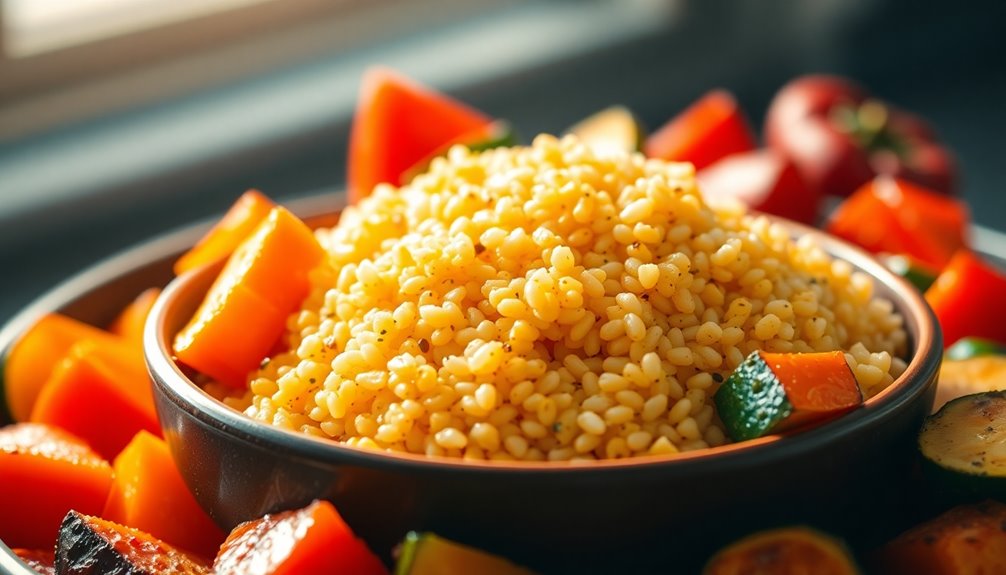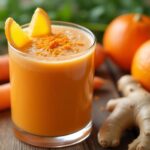Batch-cooking quinoa and veggies is a clever way to make sure you've got nutritious meals ready to go. Quinoa is a complete protein, rich in essential amino acids and gluten-free, making it suitable for various diets. To cook it perfectly, rinse and toast before boiling; this enhances flavor. Pair your quinoa with roasted seasonal veggies for a burst of color and nutrients. Spice things up with cumin, garlic powder, and fresh herbs. Portion your meals in mason jars for grab-and-go convenience. This method not only saves time but also lets you explore diverse flavors and ingredients. There's much more to this nutritious meal prep technique.
Key Takeaways
- Rinse quinoa to remove saponin, then toast before boiling for enhanced flavor and cook using the absorption method.
- Batch-cook quinoa and seasonal veggies to save time, ensuring you have nutritious meals ready for the week.
- Portion meals into mason jars for easy grab-and-go convenience and visually appealing presentations.
- Experiment with spices like cumin and garlic powder, and add fresh herbs for depth of flavor in your dishes.
- Incorporate protein sources like chickpeas or grilled chicken to boost nutritional value and customize meals to dietary preferences.
Benefits of Quinoa
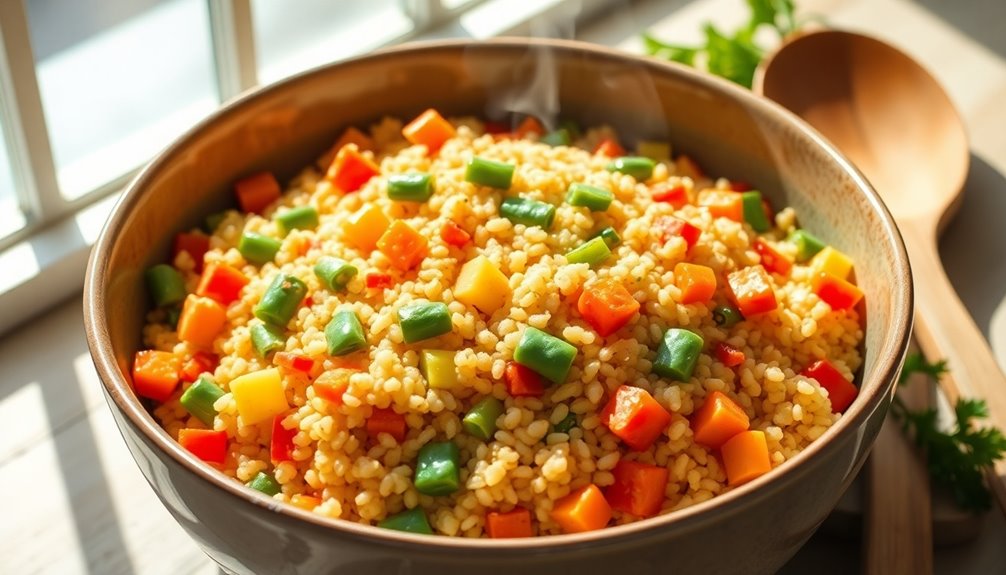
Quinoa, often hailed as a superfood, offers a variety of benefits that make it a smart addition to your diet. Its impressive nutritional value sets it apart from many other grains.
Packed with protein, fiber, and essential amino acids, quinoa is a complete protein source, which means it contains all nine essential amino acids your body needs. This makes it a fantastic choice for those following a plant-based diet or anyone looking to boost their protein intake.
As a versatile ingredient, quinoa can be incorporated into numerous dishes, from salads to stir-fries, or even as a base for hearty bowls. You can enjoy it hot or cold, sweet or savory, allowing you to get creative in the kitchen while enjoying its many benefits. Plus, it's a gluten-free option, making it accessible for those with gluten sensitivities or celiac disease.
Sustainability is another major benefit of quinoa. It's a resilient crop that requires less water than many traditional grains, making it a more environmentally friendly choice. By including quinoa in your meals, you're not just nourishing your body; you're also supporting sustainable agricultural practices.
Choosing Your Vegetables
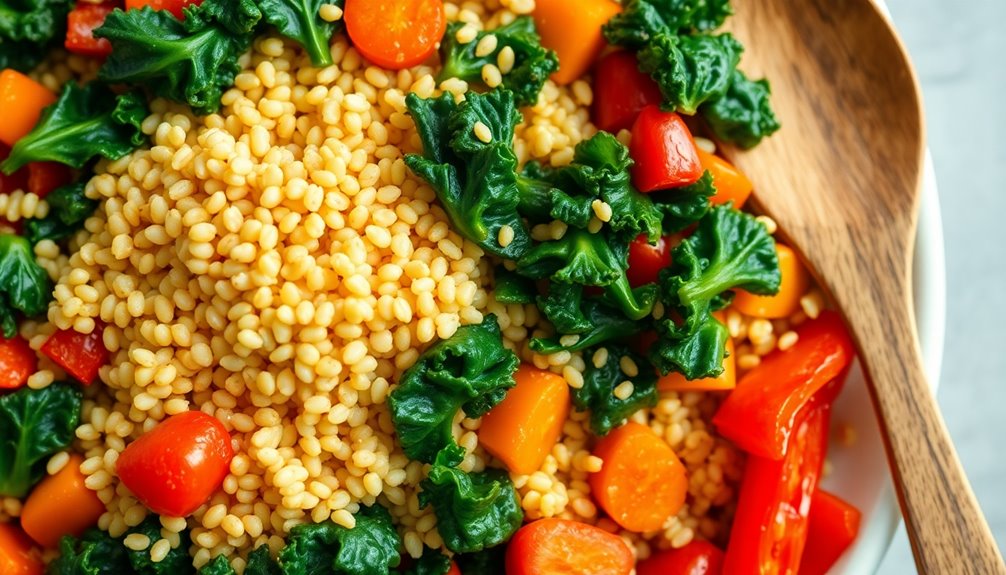
When you're preparing a batch of quinoa and veggies, choosing the right vegetables can elevate your dish greatly. To make the most of your meal prep, consider incorporating seasonal produce. Not only does this guarantee peak freshness and flavor, but it also supports local farmers and reduces your carbon footprint.
For instance, in spring, you might opt for asparagus and peas, while fall calls for butternut squash and Brussels sprouts. Seasonal veggies are often more affordable, too, allowing you to enjoy a variety of options without breaking the bank.
Next, think about colorful combinations. Incorporating a range of hues isn't just visually appealing; it also enhances the nutritional value of your dish. Each color typically represents different vitamins and minerals, so mixing carrots, bell peppers, and purple cabbage can provide you with a well-rounded meal.
You don't have to stick to one type of vegetable; experimenting with different textures and flavors can make your batch-cooked quinoa and veggies more exciting and satisfying.
Cooking Quinoa Perfectly
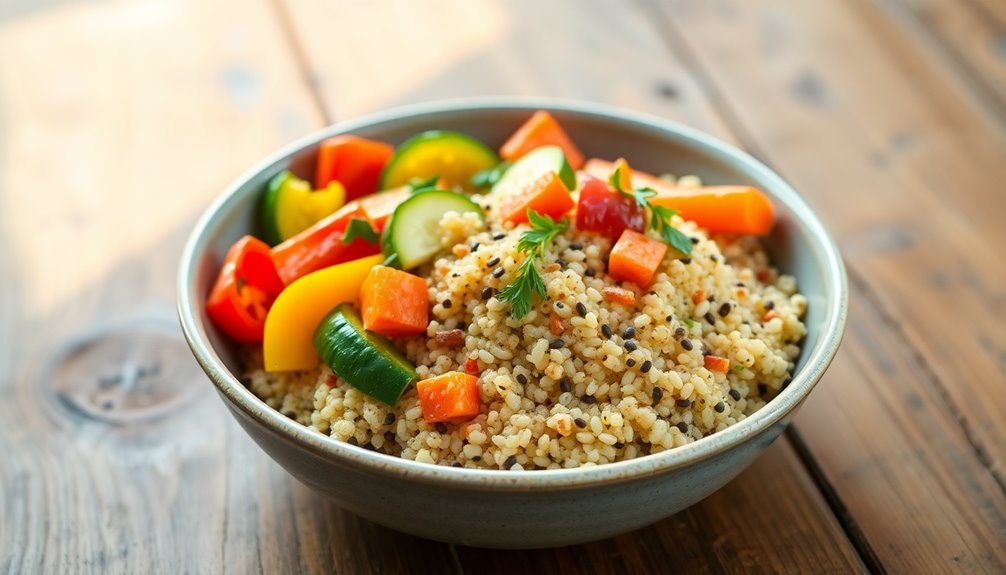
Getting the most out of your colorful vegetable selection starts with perfectly cooked quinoa. This tiny grain packs a powerful nutritional punch, but its texture can make or break your dish. To achieve that ideal fluffy consistency, begin by rinsing your quinoa thoroughly under cold water. This removes the natural coating, called saponin, which can impart a bitter taste.
Next, let's talk about cooking techniques. The most common method is the absorption method: for every cup of quinoa, use two cups of water or broth. Bring it to a boil, then reduce the heat to a simmer and cover the pot. Cooking it for about 15 minutes usually does the trick. You want to see those little spirals separate from the grain, indicating it's ready. If you prefer a nuttier flavor, toasting the quinoa in a dry skillet for a few minutes before boiling is a game changer.
Once cooked, let it sit covered for about five minutes to allow it to steam. Fluffing it with a fork afterward helps create that perfect quinoa texture. If you're batch cooking, portion it out into containers, and it'll be ready to complement your veggies throughout the week.
Meal Prep Tips
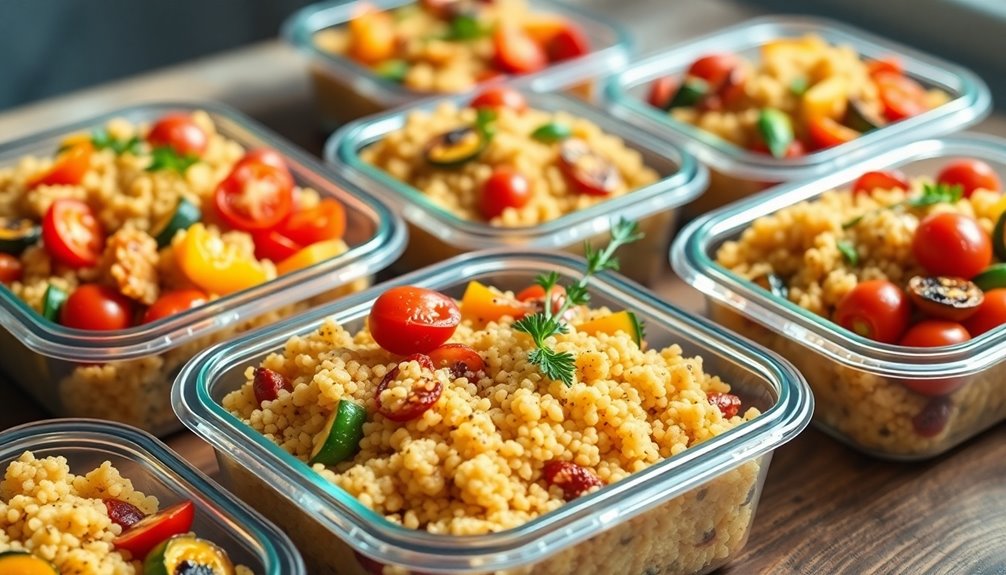
To make your meal prep efficient and hassle-free, start by planning your meals for the week ahead. This strategy not only saves time but also reduces the stress of daily cooking. Take a few minutes each weekend to jot down your meal ideas, focusing on batch-cooked quinoa and veggies. By having a clear plan, you can streamline your shopping list and avoid impulse buys at the grocery store.
Next, focus on time management. Set aside a specific day and time for your meal prep. Whether it's Sunday afternoon or Wednesday evening, having a designated prep day helps you stay consistent.
You'll find that cooking larger portions of quinoa and veggies at once will cut down on the time you spend in the kitchen throughout the week.
Don't forget about portion control! Dividing your meals into individual containers not only helps you with balanced eating but also makes it easier to grab a healthy meal on busy days. Aim for a mix of quinoa and veggies in each container, ensuring you're getting the nutrients you need.
Flavor Enhancements
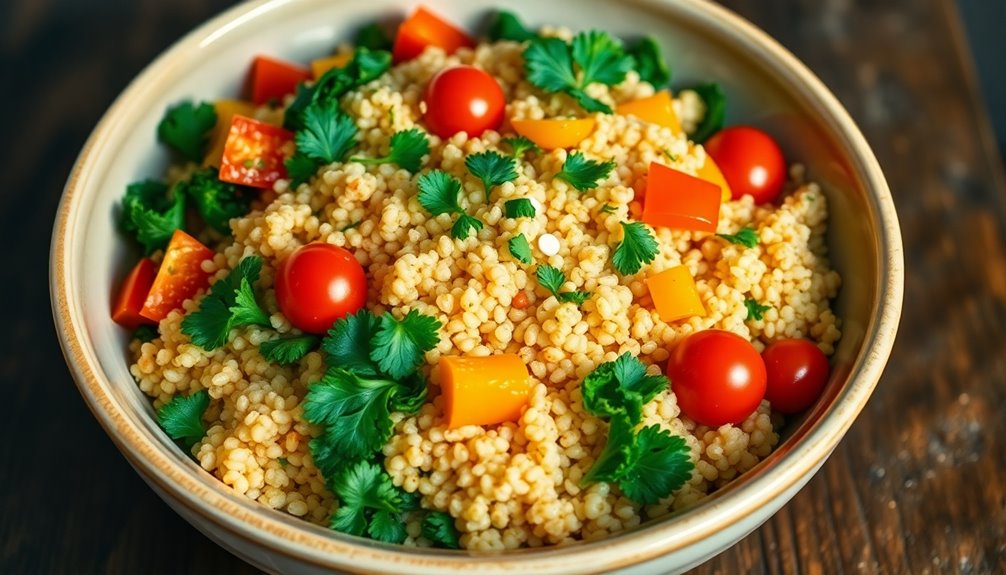
Often, incorporating flavor enhancements into your batch-cooked quinoa and veggies can transform a simple meal into a delightful experience. To elevate the taste, consider various seasoning options that can complement your ingredients.
For instance, using spices like cumin, smoked paprika, or garlic powder can add depth and warmth. Fresh herbs like cilantro or parsley can also provide a burst of freshness.
Experimenting with cooking techniques can also enhance flavors. Roasting your veggies instead of steaming them can bring out their natural sweetness and create a pleasant caramelization. You might even try sautéing them with a splash of olive oil and your favorite spices for added richness.
When it comes to taste pairings, think about how different flavors can work together. Adding a squeeze of lemon juice or a drizzle of balsamic glaze can brighten your dish, while a sprinkle of feta or nutritional yeast can introduce a savory element. Don't forget the power of umami; ingredients like sun-dried tomatoes or mushrooms can take your meal to the next level.
Lastly, presentation ideas can make your meal feel special. Layering quinoa and veggies in a bowl, garnishing with fresh herbs, or serving with a colorful side salad can create an inviting look. By focusing on these flavor enhancements, you'll not only enjoy a more delicious meal, but also foster a sense of community and belonging around the dinner table.
Storage Solutions
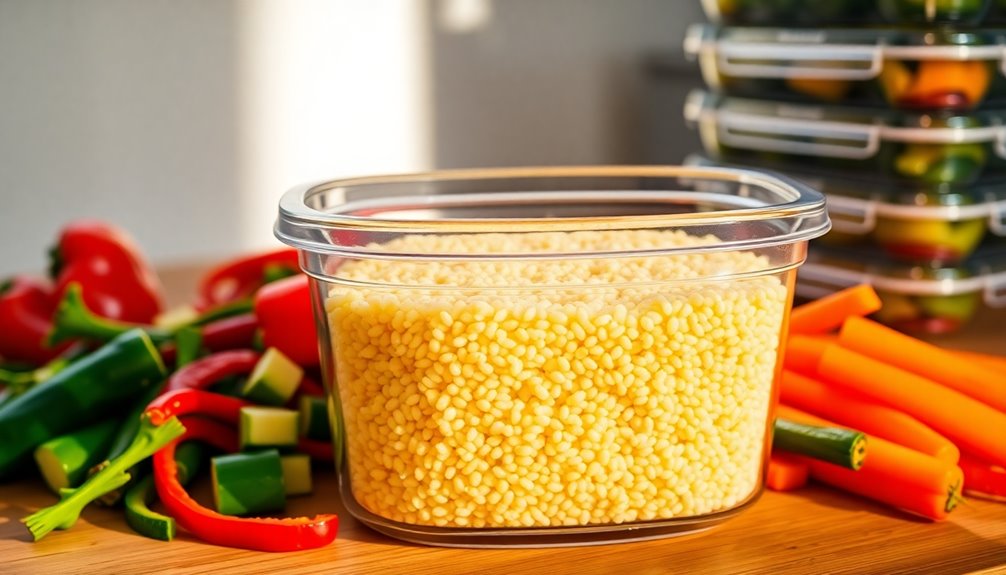
When it comes to storing batch-cooked quinoa and veggies, proper methods can save you time and guarantee your meals stay fresh. To make sure your food maintains its flavor and texture, selecting the right container options and using effective freezing tips are vital.
For container options, consider the following:
| Container Type | Best Use |
|---|---|
| Glass Containers | Ideal for refrigeration |
| BPA-free Plastic Jars | Great for portioning |
| Freezer Bags | Perfect for freezing |
| Airtight Containers | Best for long-term storage |
Glass containers are excellent for reheating and are eco-friendly, while BPA-free plastic jars are lightweight and great for meal prep. Freezer bags allow you to save space and easily label your meals, which is essential for organization. Airtight containers can keep your quinoa and veggies fresh for longer periods.
When freezing, let your quinoa and veggies cool down to room temperature before packing them. This prevents moisture buildup that can lead to freezer burn. Additionally, try to remove as much air as possible from your containers or bags to maintain quality. Label each container with the date and contents to keep track of freshness.
Serving Suggestions
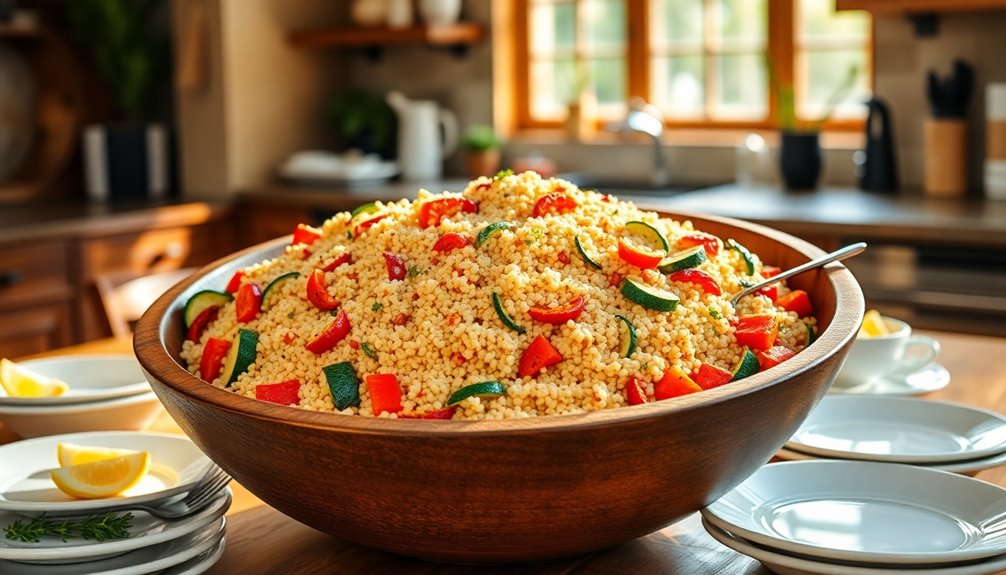
Serving batch-cooked quinoa and veggies can be as versatile as your culinary creativity allows. You can elevate your meals by considering some creative pairings and thoughtful presentation ideas. These elements not only enhance flavor but also make your dishes visually appealing—perfect for sharing with family or friends.
Start with the base of quinoa and veggies, then think about what flavors you enjoy. For instance, adding roasted chickpeas or grilled chicken can provide a protein boost, while a drizzle of tahini or a sprinkle of feta can add creaminess and tang. Fresh herbs like parsley or cilantro can brighten the dish, making it more inviting. Don't shy away from experimenting with spices either; a dash of cumin or smoked paprika can transform the taste profile entirely.
When it comes to presentation ideas, consider using vibrant bowls or plates that contrast with the colors of your dish. Layering ingredients can create a more dynamic look; for example, serving quinoa as a base, topped with colorful veggies, and garnished with herbs can make your dish pop.
You can also use mason jars for individual servings, showcasing the layers and making it easy to grab-and-go.
Ultimately, the key is to create meals that not only satisfy your hunger but also foster a sense of community and connection. Sharing your batch-cooked quinoa and veggies in visually appealing ways encourages everyone to gather around the table, making mealtime a cherished experience.
Recipe Variations
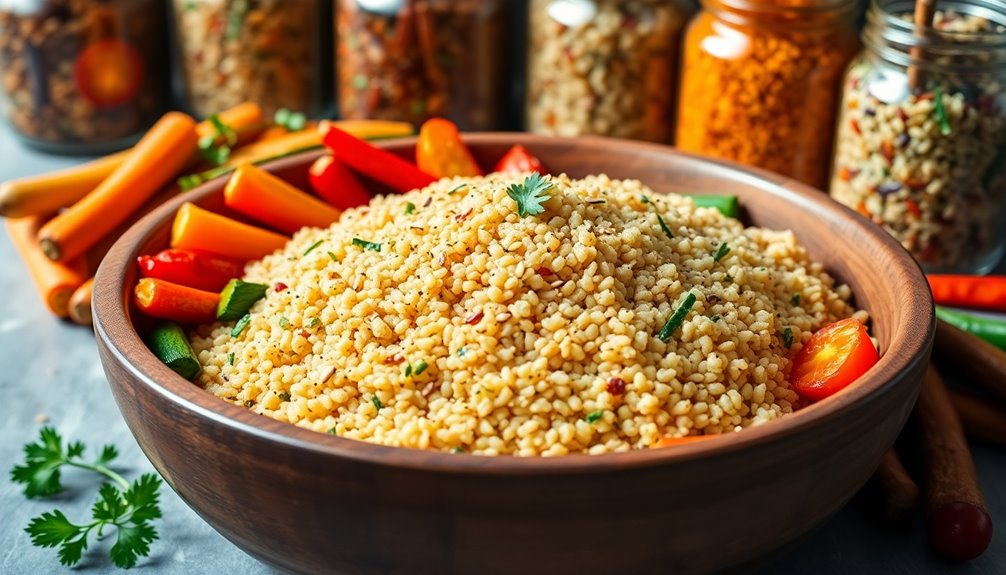
Exploring recipe variations for your batch-cooked quinoa and veggies can open up a world of flavors and textures that keep meals exciting. By making a few simple ingredient substitutions and experimenting with seasoning options, you can transform your dish to suit your taste and dietary needs.
Here are three ideas to get you started:
- Ingredient Substitutions: Swap out quinoa for other grains like farro, bulgur, or brown rice for a different texture. You can also use various veggies based on what you have on hand or what's in season. Think about incorporating sweet potatoes, zucchini, or even kale to add color and nutrients.
- Seasoning Options: Instead of sticking to basic salt and pepper, explore different herbs and spices. Try adding garlic powder, cumin, or smoked paprika for a warm flavor. Fresh herbs like cilantro or basil can brighten up your dish, while a splash of lemon juice or balsamic vinegar can add a tangy kick.
- Protein Add-Ins: Enhance the nutritional value of your meal by adding protein. You could mix in canned chickpeas, lentils, or even grilled chicken. Tofu or tempeh are great vegetarian options that absorb the flavors of your seasonings beautifully.
Frequently Asked Questions
Can Quinoa Be Eaten Cold After Meal Prepping?
Absolutely, you can enjoy cold quinoa after meal prepping! It's perfect for cold quinoa salads, where you can mix in your favorite veggies and a zesty dressing for a revitalizing dish.
You might also consider making quinoa sushi rolls; they're fun, nutritious, and a great way to use leftover quinoa. Just remember to store it properly in the fridge to maintain freshness.
Enjoy these versatile options at your next meal!
How Long Can I Store Cooked Quinoa in the Fridge?
Oh, the great mystery of cold quinoa in your refrigerator! You'd think it could last forever, but alas, even quinoa needs its beauty sleep.
You can store cooked quinoa in the fridge for about 3 to 5 days. Make sure it's in an airtight container to keep it fresh and delicious. After that, it's best to toss it out—nobody wants a science experiment lurking in their fridge!
Enjoy your cold quinoa while it's still good!
Is It Safe to Freeze Cooked Quinoa?
Yes, it's safe to freeze cooked quinoa! To freeze, use an airtight container or freezer bag, ensuring you remove as much air as possible. This freezing method helps maintain its texture and flavor.
When you're ready to enjoy it, thaw quinoa in the fridge overnight or use the microwave's defrost setting. Remember, proper storage and the thawing process are key to keeping your quinoa tasty and nutritious for future meals.
Can I Use Leftover Quinoa for Other Recipes?
Imagine your leftover quinoa as a treasure chest, filled with possibilities. You can transform it into vibrant quinoa salads bursting with fresh veggies or hearty quinoa burgers that satisfy your cravings. By using leftovers creatively, you not only reduce waste but also nourish yourself with delicious meals.
Quinoa's versatility means it can fit into various recipes, making you feel like a culinary artist while ensuring you belong to a community valuing sustainability.
How Do I Reheat Batch-Cooked Quinoa Effectively?
To reheat your leftovers effectively, you've got a couple of solid options.
For the microwave method, place your quinoa in a bowl, add a splash of water, cover it, and heat in short bursts, stirring in between.
If you prefer the stovetop method, warm it in a skillet with a bit of olive oil or broth, stirring until heated through.
Both methods are quick and perfect for meal prep, ensuring your quinoa tastes fresh!
Conclusion
Incorporating batch-cooked quinoa and veggies into your meal prep routine is a delightful way to nourish your body without the fuss. By embracing this nutritious duo, you're not just filling your plate; you're also inviting a world of flavor and health benefits into your kitchen. With a little creativity and planning, you'll transform simple ingredients into culinary masterpieces that last throughout the week. So, let your taste buds dance and enjoy the wholesome goodness that comes your way!

